A Class with Drucker - Headway | Work on yourself
A Class with Drucker - Headway | Work on yourself
A Class with Drucker - Headway | Work on yourself
Create successful ePaper yourself
Turn your PDF publications into a flip-book with our unique Google optimized e-Paper software.
156 ■ A CLASS WITH DRUCKER<br />
INTERNAL JOB-RELATED ACTIVITIES<br />
There are many job-related activities that cut across organizati<strong>on</strong>al lines and<br />
for which you do not need a permanent organizati<strong>on</strong>. I was not a fan of the<br />
Total Quality Management (TQM) movement, which was very popular several<br />
years ago, because of the way it was practiced in many organizati<strong>on</strong>s. I<br />
certainly agreed that quality was central and that ownership was important<br />
and that c<strong>on</strong>tinuous improvement was an eminently worthy goal. The problem,<br />
as I saw it, was in the way TQM was applied, or rather misapplied,<br />
which actually caused more problems than it solved in some organizati<strong>on</strong>s.<br />
Still, there were various c<strong>on</strong>cepts promoted as integral parts of “TQM”<br />
which were quite good. One was the process acti<strong>on</strong> team, sometimes<br />
referred to as a PAT team. The idea of the PAT team was that the team,<br />
made up of members from a number of relevant organizati<strong>on</strong>s, would<br />
study a problem or opportunity originally focused <strong>on</strong> a process rather than<br />
an objective, and then present a soluti<strong>on</strong> that would be implemented. This<br />
is where the c<strong>on</strong>cept, as practiced, sometimes ran into trouble.<br />
The team was “empowered,” and its soluti<strong>on</strong> wasn’t merely a recommendati<strong>on</strong>.<br />
Management was supposed to commit to implementati<strong>on</strong> of<br />
whatever the team came up <str<strong>on</strong>g>with</str<strong>on</strong>g>, like it or not. That was the problem. Not<br />
<strong>on</strong>ly did the team operate <str<strong>on</strong>g>with</str<strong>on</strong>g>out the benefit of an overall management<br />
perspective, but the situati<strong>on</strong> might have changed by the time they completed<br />
their analysis. However, this doesn’t mean that the idea of cross-discipline<br />
problem-solving teams wasn’t a good idea. Emphasis <strong>on</strong> teamwork<br />
is here to stay, and problem-solving teams of this type present an excellent<br />
opportunity to see the leadership of participants at all levels of experience,<br />
professi<strong>on</strong>, and management <str<strong>on</strong>g>with</str<strong>on</strong>g>in an organizati<strong>on</strong>.<br />
INTERNAL SOCIETAL-BENEFIT ACTIVITIES<br />
Many companies take <strong>on</strong> tasks which are primarily for the benefit of<br />
organizati<strong>on</strong>s outside of the company, but are d<strong>on</strong>e <strong>on</strong> the company’s<br />
premises and usually <strong>on</strong> company time. Community fund drives and savings-b<strong>on</strong>d<br />
drives are a couple of examples. Some companies simply give<br />
these tasks to a secretary or to the most junior member of the organizati<strong>on</strong>.<br />
To me, that is a waste of an excellent opportunity to get to know and<br />
give leadership experience to some of your younger managers.<br />
I <strong>on</strong>ce met a young man who had advanced very rapidly in his company<br />
as an engineer. I learned that his “breakthrough” assignment came<br />
shortly after his hiring, but had little to do <str<strong>on</strong>g>with</str<strong>on</strong>g> his regularly assigned


